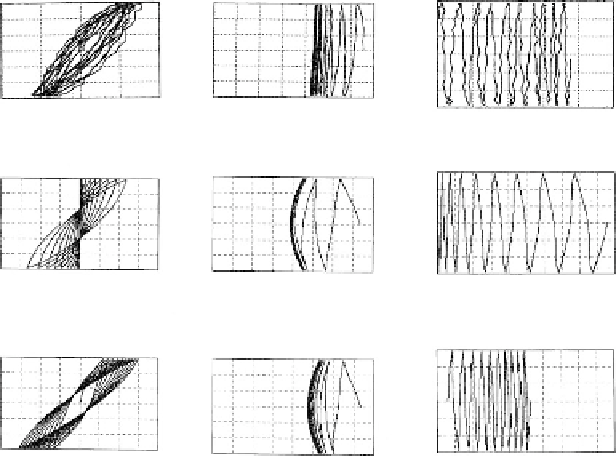Geoscience Reference
In-Depth Information
15
10
5
15
10
5
15
10
5
Experiment
0
0
0
−5
−10
−
−
5
−
10
−
−
5
−
10
−
15
15
−0.2
15
−0.1
0
0.1
0.2
0
10
20
30
40
50
60
70
0
0.2
0.4
0.6
0.8
Shear strain (%)
(a) Measured
Mean effective stress (kPa)
Vertical strain (%)
15
10
5
15
10
5
15
10
5
0
0
0
5
5
−
−
5
−
−
10
−
10
−
10
−
15
−
15
−
15
−
20
−
10 0
Shear strain (%)
10
20
0
20
40
60
80
0 0 0 0 0 0
Axial strain (%)
Mean effective stress (kPa)
(b) Computed by conventional model
15
10
5
15
10
5
15
10
5
0
0
0
−
5
−
10
−
−
5
−
5
−
10
−
−
10
15
−
15
15
−
0.2
−
0.1
0.0
0.1
0.2
0
20
40
60
80
0.0
0.2
0.4
0.6
0.8
1.0
Shear strain (%)
Mean effective stress (kPa)
Axial strain (%)
(c) Computed by modified model
Fig. 13.4. Stress-strain and stresspath for lateral normal strainunconstrained with
constant axial stressdifference (Ozutsumi, 2003)
Japan, during 1993 Hokkaido-Nanseioki earthquake of Richter magnitude 7.8, poses
a new challenge. This dike was heavily damaged during the earthquake as shown in
Figure 13.5. The dike was constructed on loosely deposited sandy deposit with a thick-
ness of about 5mas shown inFigure 13.6.
The results of the analysis typically show a pattern of deformation such as shown in
Figure 13.7. However, the degree of deformation is found to be excessively sensitive
to the type of algorithm and the details in the computation scheme for time integra-
tion. When the modification in the algorthim for computing dilatancy discussed earlier
is adopted with improved integration scheme, the result shows very small settlements as
shown inCaseAin Figure 13.8.
Since the shear strains induced in the foundation soil are in the order of several tens
of percent, effect of residual strength
S
us
are studied in addition to the effect of cyclic
mobility.TheresultsareshowninTable13.2andFigure13.8.Thebestfittothemeasured
crestsettlementisgivenforCaseD2buttheresidualstrength
S
us
isapparentlyverylow.
CasesC1throughC4aremoreorlessintherangeofthosereportedintheliteraturebased
on the laboratory tests.Further study in thisaspect of soilmay be necessary.

